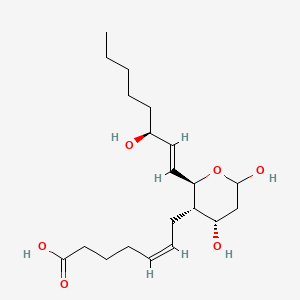| MeSH term | MeSH ID | Detail |
|---|---|---|
| Cholecystitis, Acute | D041881 | 1 associated lipids |
| Bluetongue | D001819 | 1 associated lipids |
| Atrial Premature Complexes | D018880 | 1 associated lipids |
| Gastric Dilatation | D013271 | 1 associated lipids |
| Latex Hypersensitivity | D020315 | 1 associated lipids |
| Stomach Volvulus | D013277 | 1 associated lipids |
| Foot Rot | D005535 | 1 associated lipids |
| Frostbite | D005627 | 1 associated lipids |
| Strongyle Infections, Equine | D013319 | 1 associated lipids |
| Basal Ganglia Hemorrhage | D020145 | 1 associated lipids |
| Edema, Cardiac | D004489 | 1 associated lipids |
| Osteoblastoma | D018215 | 1 associated lipids |
| Radiculopathy | D011843 | 1 associated lipids |
| Oligomenorrhea | D009839 | 1 associated lipids |
| Erythromelalgia | D004916 | 1 associated lipids |
| Intracranial Hemorrhage, Hypertensive | D020299 | 1 associated lipids |
| Heart Septal Defects | D006343 | 2 associated lipids |
| Retinal Vein Occlusion | D012170 | 2 associated lipids |
| Weil Disease | D014895 | 2 associated lipids |
| Pulmonary Heart Disease | D011660 | 2 associated lipids |
Thromboxane b2
Thromboxane b2 is a lipid of Fatty Acyls (FA) class. Thromboxane b2 is associated with abnormalities such as endothelial dysfunction, Diabetes Mellitus, Non-Insulin-Dependent, Diabetes Mellitus, Ischemia and Thrombocytosis. The involved functions are known as Platelet Activation, Excretory function, Anabolism, Inflammation and mRNA Expression. Thromboxane b2 often locates in Endothelium, Hepatic and Microsomes, Liver. The associated genes with Thromboxane b2 are PTGS2 gene, prothrombin fragment 2 and CCL14 wt Allele.
Cross Reference
Introduction
To understand associated biological information of Thromboxane b2, we collected biological information of abnormalities, associated pathways, cellular/molecular locations, biological functions, related genes/proteins, lipids and common seen animal/experimental models with organized paragraphs from literatures.
What diseases are associated with Thromboxane b2?
Thromboxane b2 is suspected in endothelial dysfunction, Diabetes Mellitus, Non-Insulin-Dependent, Diabetes Mellitus, Ischemia, Thrombocytosis, Acute Coronary Syndrome and other diseases in descending order of the highest number of associated sentences.
Related references are mostly published in these journals:
| Disease | Cross reference | Weighted score | Related literature |
|---|
Possible diseases from mapped MeSH terms on references
We collected disease MeSH terms mapped to the references associated with Thromboxane b2
PubChem Associated disorders and diseases
What pathways are associated with Thromboxane b2
There are no associated biomedical information in the current reference collection.
PubChem Biomolecular Interactions and Pathways
Link to PubChem Biomolecular Interactions and PathwaysWhat cellular locations are associated with Thromboxane b2?
Visualization in cellular structure
Associated locations are in red color. Not associated locations are in black.
Related references are published most in these journals:
| Location | Cross reference | Weighted score | Related literatures |
|---|
What functions are associated with Thromboxane b2?
Related references are published most in these journals:
| Function | Cross reference | Weighted score | Related literatures |
|---|
What lipids are associated with Thromboxane b2?
There are no associated biomedical information in the current reference collection.
What genes are associated with Thromboxane b2?
Related references are published most in these journals:
| Gene | Cross reference | Weighted score | Related literatures |
|---|
What common seen animal models are associated with Thromboxane b2?
There are no associated biomedical information in the current reference collection.
NCBI Entrez Crosslinks
All references with Thromboxane b2
Download all related citations| Authors | Title | Published | Journal | PubMed Link |
|---|---|---|---|---|
| Ferrari D et al. | Cyanidin-3-O-glucoside inhibits NF-kB signalling in intestinal epithelial cells exposed to TNF-α and exerts protective effects via Nrf2 pathway activation. | 2016 | Toxicol. Lett. | pmid:27793764 |
| Morel A et al. | The increased level of COX-dependent arachidonic acid metabolism in blood platelets from secondary progressive multiple sclerosis patients. | 2016 | Mol. Cell. Biochem. | pmid:27507559 |
| Gonzalez-Paredes FJ et al. | Contribution of Cyclooxygenase End Products and Oxidative Stress to Intrahepatic Endothelial Dysfunction in Early Non-Alcoholic Fatty Liver Disease. | 2016 | PLoS ONE | pmid:27227672 |
| Kakouros N et al. | Risk Factors for Nonplatelet Thromboxane Generation After Coronary Artery Bypass Graft Surgery. | 2016 | J Am Heart Assoc | pmid:27068626 |
| Olszowski T et al. | The Effect of Cadmium on COX-1 and COX-2 Gene, Protein Expression, and Enzymatic Activity in THP-1 Macrophages. | 2015 | Biol Trace Elem Res | pmid:25645360 |
| Al-Husseini A et al. | Increased eicosanoid levels in the Sugen/chronic hypoxia model of severe pulmonary hypertension. | 2015 | PLoS ONE | pmid:25785937 |
| Mateu A et al. | Cross-talk between TLR4 and PPARγ pathways in the arachidonic acid-induced inflammatory response in pancreatic acini. | 2015 | Int. J. Biochem. Cell Biol. | pmid:26510582 |
| Khanna V et al. | Does the response to aspirin and clopidogrel vary over 6 months in patients with ischemic heart disease? | 2015 | J. Thromb. Haemost. | pmid:25809653 |
| Wu F et al. | Valsartan decreases platelet activity and arterial thrombotic events in elderly patients with hypertension. | 2015 | Chin. Med. J. | pmid:25591555 |
| Paikin JS et al. | Multiple daily doses of acetyl-salicylic acid (ASA) overcome reduced platelet response to once-daily ASA after coronary artery bypass graft surgery: a pilot randomized controlled trial. | 2015 | J. Thromb. Haemost. | pmid:25546465 |
